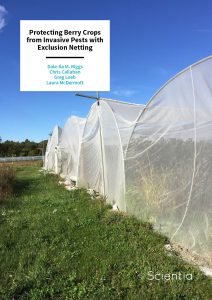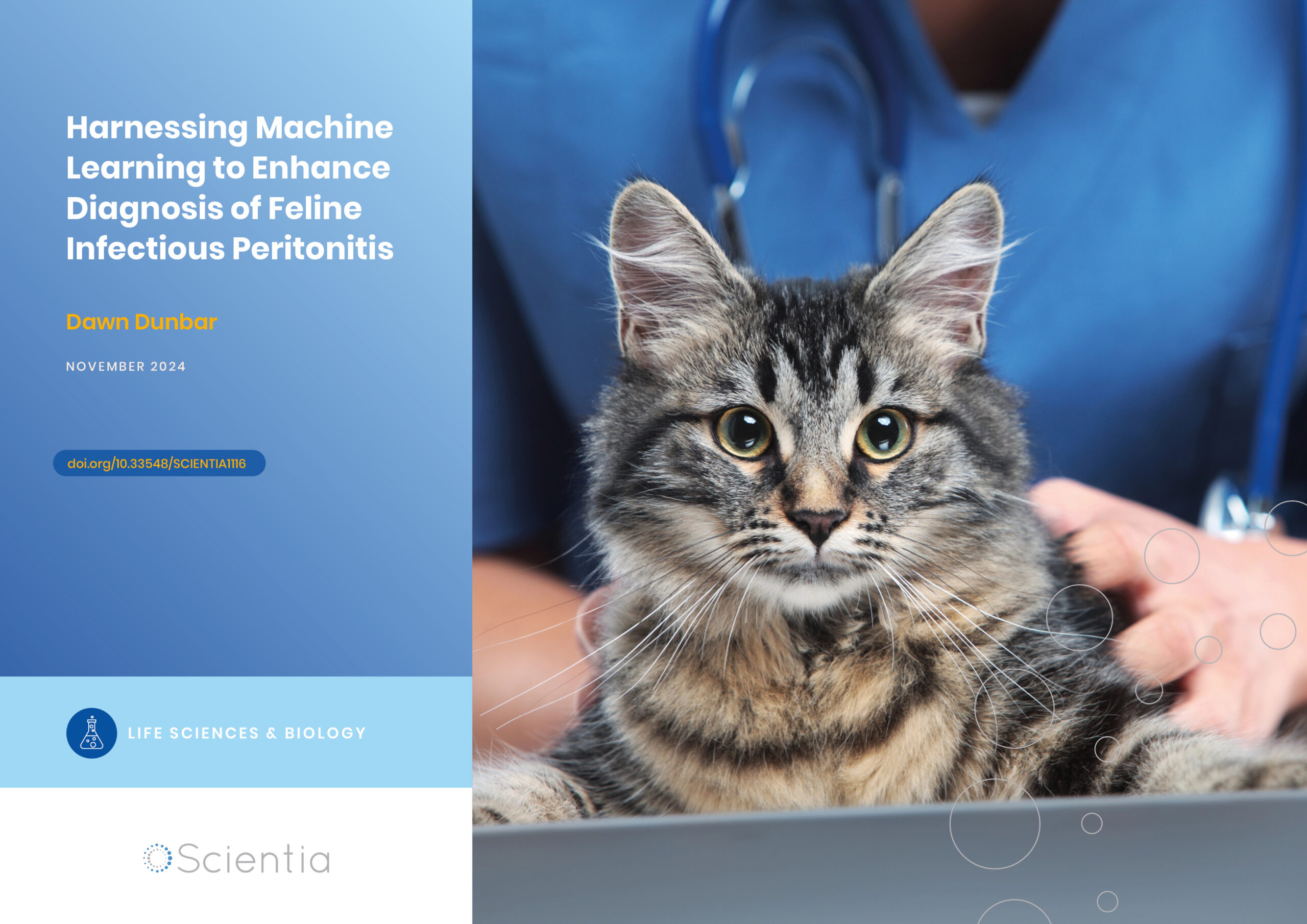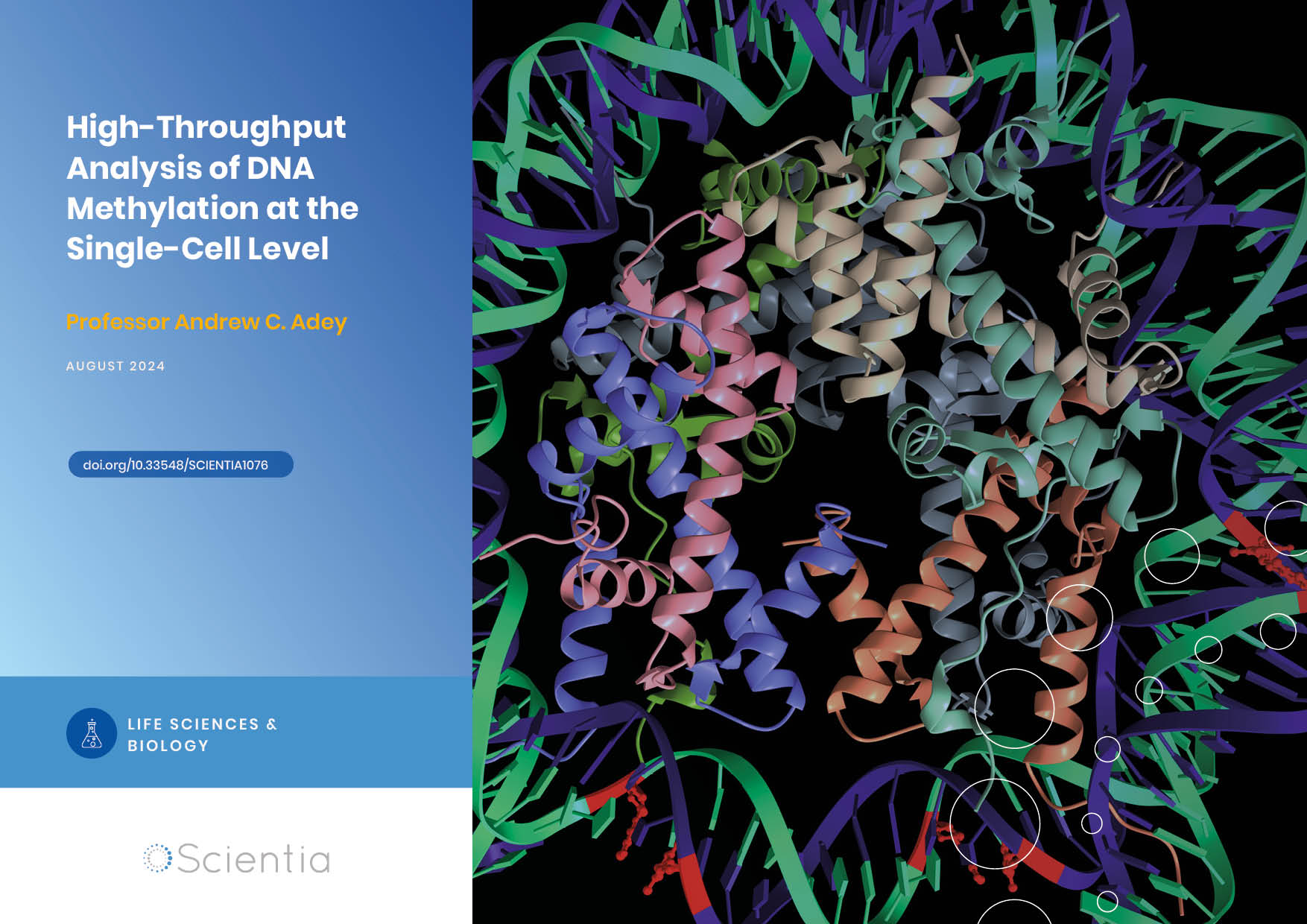Dale-Ila Riggs | Protecting Berry Crops from Invasive Pests with Exclusion Netting
Berry crops are vulnerable to numerous invasive pests, including spotted wing drosophila. These fruit flies have caused significant losses for farmers growing berries in different parts of the US, Asia, and Europe. A few years ago, Dale-Ila Riggs, the owner and operator of The Berry Patch, developed and implemented a series of exclusion netting systems that can effectively protect berry crops from spotted wing drosophila and other environmental threats, reducing the need for chemical pesticides.
A Major Risk for Berry Crops
Successfully growing berries, such as strawberries, raspberries, blackberries, and blueberries, can be a very challenging task. Berry crops are vulnerable to numerous pests and environmental threats, including severe weather, fungi, rodents, moths and fruit flies.
One of the most destructive fruit fly species for berry crops is the spotted wing drosophila. These invasive fruit flies, which originate from southeast Asia, have now become a major threat to soft-skinned fruit crops across the US and Europe.
Spotted wing drosophila can cause significant damage to berries. Unlike other species of fruit fly, they lay eggs into soft-skinned fruits as they are ripening. Fruits infested by their eggs typically decompose from the inside, due to the larvae feeding on them.
Raspberries, blackberries, strawberries, cherries and blueberries are particularly vulnerable to spotted wing drosophila. However, this invasive pest can also infest other soft-skinned fruits, including grapes, along with damaged pears, peaches, nectarines, and tomatoes. Noticing these flies and protecting fruits from potential infestations is now a critical challenge for many crop growers.
To reduce the risk of infestations, most non-organic farmers use chemical pesticides, with varied and inconsistent results. Such pesticides can cause great harm to natural enemies, butterflies and other pollinators, damaging local ecosystems and ecosystem services. Many consumers are also concerned about the potentially harmful effects of pesticide residues on the berries they eat.
Organic farmers, on the other hand, rely mostly on a single ‘organically approved’ pesticide, which can only be applied twice to a crop, before rotating to other organic materials that have limited effectiveness.
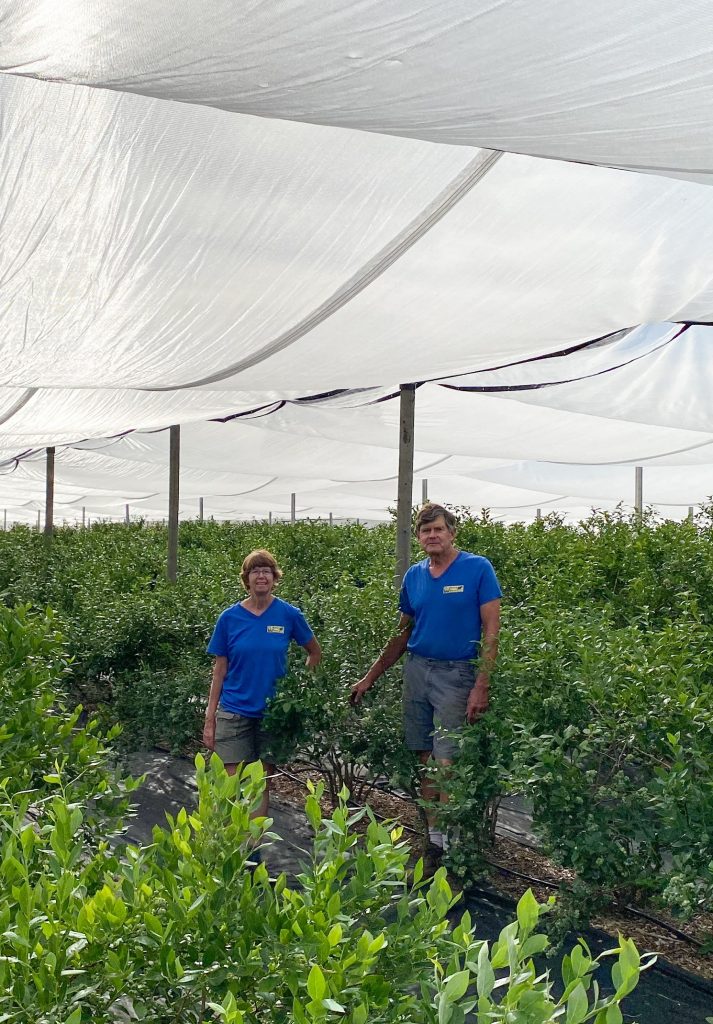
Dale-Ila Riggs and her husband, Don Miles, standing under their exclusion netting on their farm.
Exclusion Netting
A few years ago, Dale-Ila Riggs, Plant Science graduate and owner of The Berry Patch in Stephentown, New York State, devised an exclusion netting system that protects berry crops from spotted wing drosophila and other pests, reducing the need for chemical pesticides. The main idea behind this system is to physically exclude pests from the sites where crops are growing.
‘The biggest problem with spotted wing drosophila is that by the time you know it is on your farm, it is virtually too late to control it,’ explains Riggs. ‘It lays its eggs in fruit that are just starting to ripen and matures so quickly that when ripe fruit is picked it is contaminated by maggots. Reliable traps have not yet been developed, so growers have had to abandon integrated pest management principles of monitoring and treating at a given threshold.’
In the Northeast, where The Berry Patch is located, many farmers have historically been able to grow blueberries without using insecticides. As such, many blueberry growers do not own spraying equipment and have no interest in using pesticides. However, spotted wing drosophila first appeared in the region in 2011, and has since caused significant damage to local crops, resulting in substantial financial losses for farmers.
Riggs started working on her exclusion netting system after she experienced a 40% loss in her blueberries and 25% loss in her raspberries in 2012 due to a spotted wing drosophila infestation. She soon realised that the existing solutions for protecting berry crops from these invasive pests are far from ideal. This motivated her to develop an alternative approach.
In 2014, Riggs adapted a bird netting support system for her blueberry crops to test the concept of exclusion netting. Remarkably, she found that this system protected her crops from spotted wing drosophila infestations far more effectively than the pesticides and products she had tried before.
A Sophisticated Netting System
Adult females of the spotted wing drosophila species are approximately two millimetres in length and around one millimetre wide. To prevent them from accessing crops and laying eggs inside them, the netting system created by Riggs has openings of 1.05 x 0.60 millimetres.
The first version of Riggs’ exclusion netting system was created by combining two 26-foot-wide pieces of ‘ExcludeNet’ netting, placing it over her bird netting support structure made from high tunnel hoops that she had in her blueberry field. Combined, these two pieces of netting made up a 51-foot-wide sheet that could be applied down the 250-foot length of her established blueberry rows.
In contrast with pesticides and other solutions to prevent berry crop infestations, the netting system created by Riggs only needs to be installed once a year, thus eliminating the need to continuously purchase new products. Crop growers have reported that these initial installation costs were returned to them through their better crop yields after just one or two years.
To be effective, a netting system should be deployed after the crops have already been pollinated, but before fruits start gaining colour. Depending on the size of greenhouses or plantations and on the number of workers employed, setting up the netting system and storing it for the winter can take from a few hours to a couple of days.
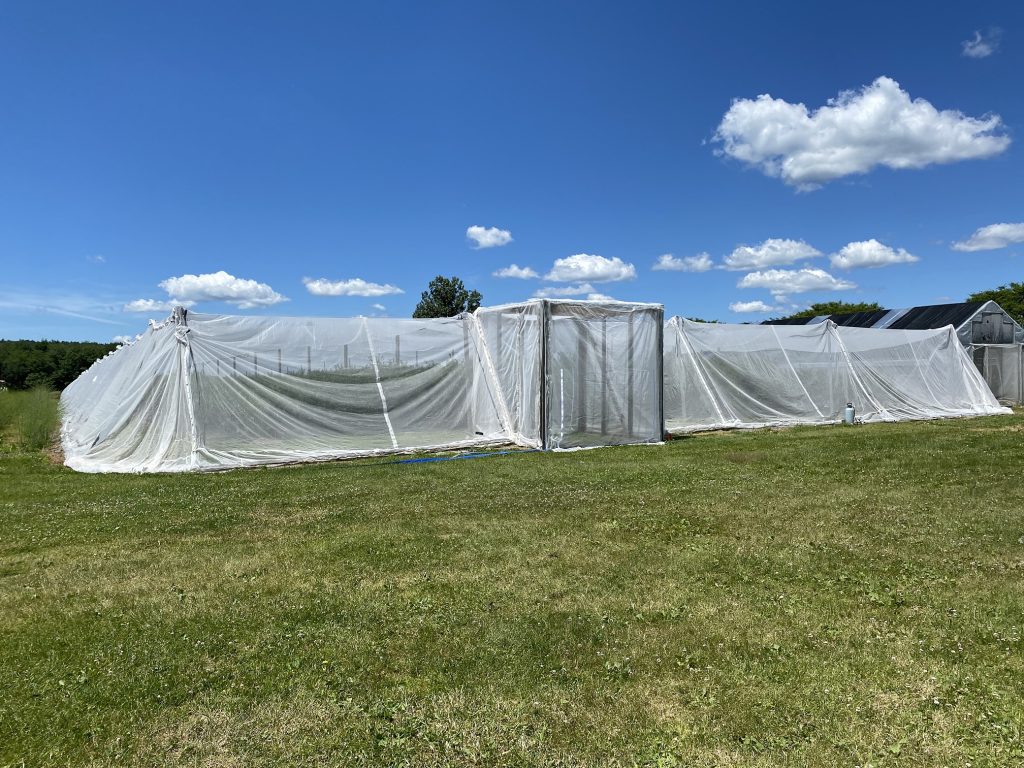
The team’s newer support structure and netting system that was erected in 2020.
Large-Scale Implementation
After introducing and testing her exclusion netting system back in 2014, Riggs achieved highly promising results. Today, she is further developing and evaluating her system, while also training berry growers in the Northeast to successfully construct and implement netting systems on their own farms.
Her new design, testing and education efforts are supported by a $15,000 grant awarded to her by Sustainable Agriculture Research and Education (SARE), an organisation that offers funding for projects that increase the sustainability of agricultural practices in the US. SARE had also financially supported her initial development and implementation of the exclusion netting system.
Riggs’ new research and development effort has many complementary objectives. Firstly, she hopes to increase the production rates of berry crops in the Northeast, using the exclusion netting system she developed to prevent fruit fly infestations and other forms of crop damage. She has achieved phenomenal yields and approximately double the fruit size of other local blueberry farms. This is due in part to the elimination of weather-related losses from heavy rain, wind, and hail. She also believes that the protective nature of the netting has a physiological impact on flower bud formation and fruit development.
Concurrently, she hopes that her work will improve the management of farm businesses, helping owners to plan for and manage pest infestations more effectively. As her netting system eliminates the need for insecticides, it could also help to improve the quality of production systems, for instance by facilitating the transition towards fully organic crop growing.
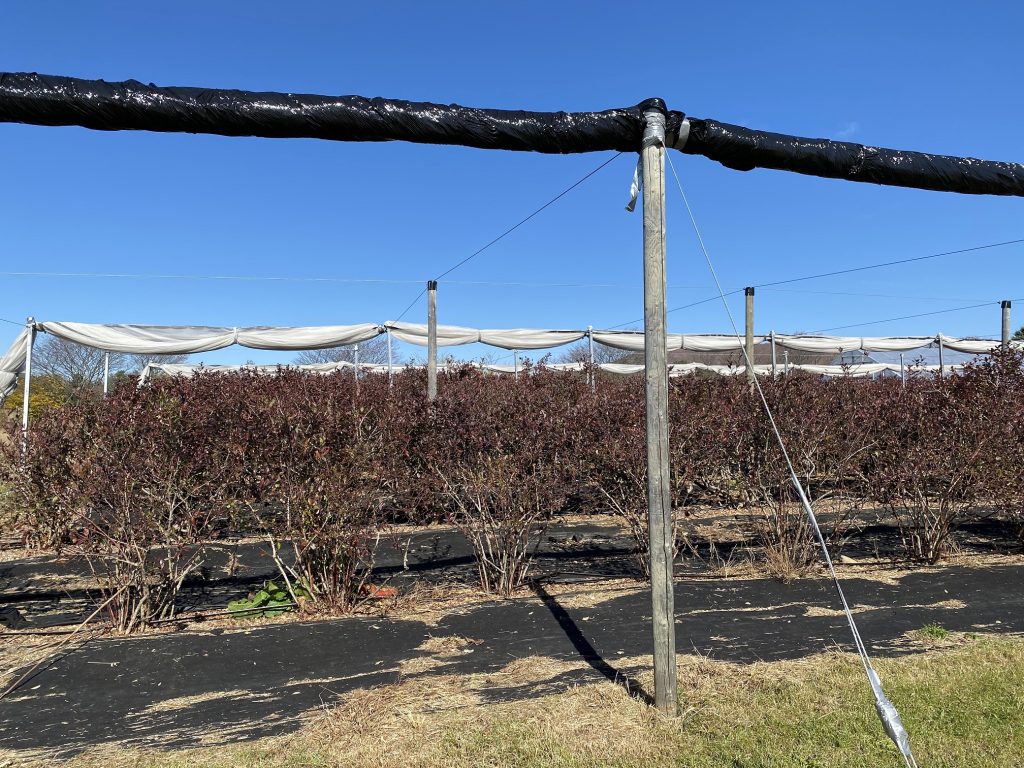
All exclusion netting stored away for winter
Training Berry Growers
As she continues to develop and evaluate her exclusion netting system, Riggs is also collaborating with researchers at different universities across the US, in order to develop tools for educating crop growers about the system. Her hope is that this will ultimately increase crop growers’ confidence in the system and encourage them to implement it on their own farms.
‘As growers come to the realisation that spotted wing drosophila is here to stay, more of them are interested in using exclusion netting,’ Riggs explains. ‘A major stumbling block for acceptance of this technique is the lack of commercial companies providing support structures and the lack of a tested design and plans for growers to construct their own structures.’
To overcome the limitations preventing many growers from implementing and testing the exclusion netting system, Riggs and her colleagues are now building and testing an engineered system that could be easier for farmers to replicate using widely available netting and other components. In addition, they are creating good-quality construction plans, a list of materials, and other resources that could guide growers who are introducing the system.
‘I want to teach growers, mainly through hands-on construction workshops and YouTube videos, how to build a system for their own farm,’ says Riggs.
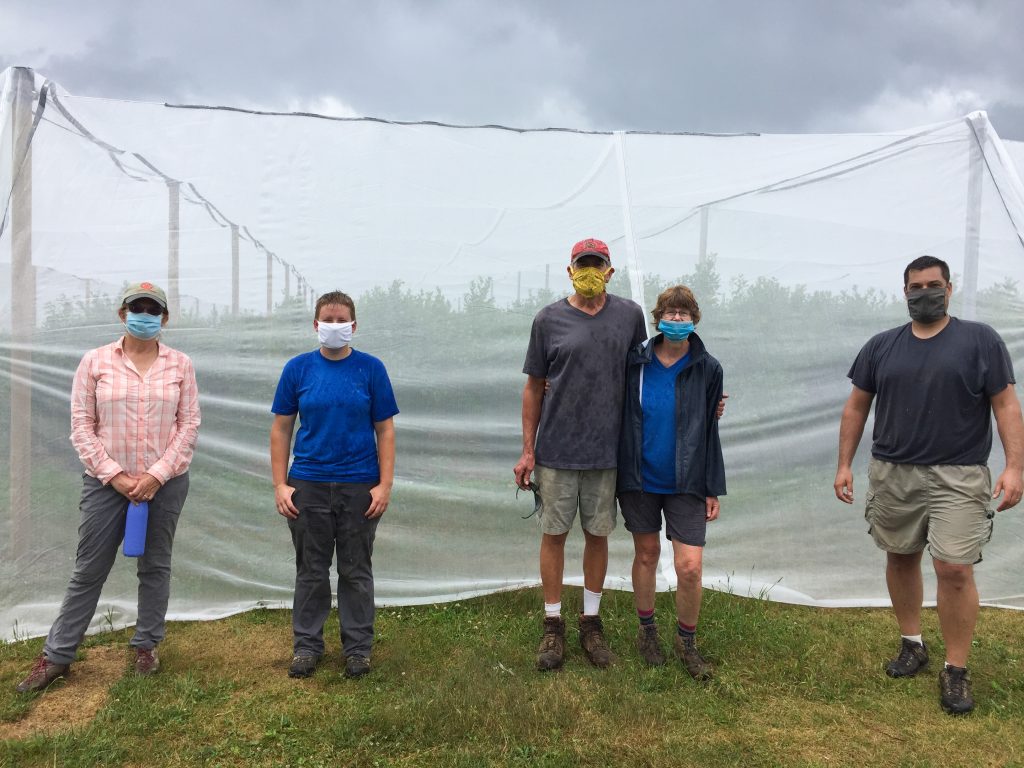
From left to right: Laura McDermott, Natasha Field, Don Miles, Dale-Ila Riggs and Chris Callahan.
Sustainable Protection Against Fruit Flies
The exclusion netting system created by Riggs is a valuable, pesticide-free solution to the problem of spotted wing drosophila infestations, which are now routinely occurring across the US and Europe. Nine years of evaluations have highlighted the great benefits of the system, showing that it outperforms insecticides in protecting berry crops from both spotted wing drosophila and other harmful pests.
‘We have had fantastic results with our exclusion netting system,’ says Riggs. ‘I have now been using it for nine years, learning and improving it slightly each year, and we have had less than 0.50% infestation of spotted wing drosophila over those nine years. In four of the nine years, we have had zero percent infestation over a 10-week harvest season, along with other beneficial effects.’
The YouTube videos, farm-based workshops, and additional resources that Riggs and her colleagues are currently developing could soon be used by berry farmers and other growers of soft-skinned fruit to improve their practices and better protect their crops from invasive pests. Ultimately, this could also lead to a reduction in the use of chemical pesticides, paving the way for greener and more sustainable agriculture.
SHARE
DOWNLOAD E-BOOK
REFERENCE
https://doi.org/10.33548/SCIENTIA867
MEET THE RESEARCHERS
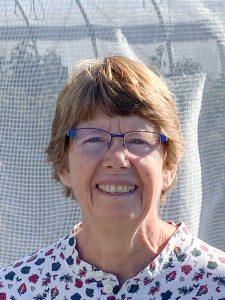
Dale-Ila M. Riggs
Owner and Operator
The Berry Patch Farm
Stephentown, NY
USA
Dale-Ila M. Riggs is the owner and operator of the Berry Patch of Stone Wall Hill Farm in Stephentown, New York. She holds a BS in Plant Science and International Agriculture from Utah State University and an MS in Horticulture and Adult Education from Oregon State University. After completing her studies, Riggs worked as an Area Horticulture Specialist at the University of Missouri Cooperative Extension for one year, and as an Area Vegetable Specialist at the Cornell Cooperative Extension for ten years. At Cornell, she developed numerous innovative research and education programs. Her work in pumpkin production also earned her the National Crop Production Award from the National Association of County Agriculture Agents. Riggs created the Berry Patch farm in 1998 with her husband, Don Miles, from a worn-out corn field. The farm includes several greenhouses, berry and vegetable tunnels, and a farm store selling fresh and seasonal produce. At the Berry Patch, Riggs is responsible for management, production, and marketing decisions. Her hard work allowed the farm to grow from a part-time operation, with less than one acre of berries spread over 91 acres, to a full-time and diversified operation, which now spans across 210 acres.
CONTACT
E: theberrypatchny@gmail.com
W: https://www.theberrypatch.net/
Chris Callahan
Extension Associate Professor of Agricultural Engineering
University of Vermont
Chris Callahan is the Associate Extension Professor of Agricultural Engineering at the University of Vermont and the Director of the Northeast Center to Advance Food Safety (NECAFS). His work focuses on the application of the engineering practice to food systems. Specific engagement is with food producers, processors, and distributors to improve efficiency, quality, safety, and cost control through the integration of technology, systems integration, and process controls. Areas of work include protected culture, postharvest handling and storage, produce safety, and sustainable energy.
Greg Loeb
Professor of Entomology
Cornell University
Greg Loeb earned his PhD in Entomology at the University of California at Davis in 1989. He came to the Department of Entomology at Cornell in 1995, where he established a research and extension program at the New York State Agricultural Experiment Station in Geneva, NY, with responsibilities for arthropod pests of grapes and small fruit crops. Since then, his lab has worked on the biology, ecology and management of a number of arthropod pests of grapes and small fruit crops, with the goal of developing sustainable and cost-effective pest-management tools.
Laura McDermott
Regional Berry Specialist
Cornell Cooperative Extension
Laura McDermot is a Senior Extension Associate and co-team leader at Cornell Cooperative Extension. She is also the Berry Specialist of the Eastern NY Commercial Horticulture Program. McDermot assists berry and vegetable farmers in eastern New York State with many production related topics of concern to direct market farms. She has helped northeastern growers adapt to a changing climate using protected agriculture technology and has conducted a wide variety of applied research relevant to improving the profitability and efficiency of berry and vegetable crop production.
KEY COLLABORATORS
Stephen Hesler, Research Support Specialist at Cornell University
Natasha Field, Technician with the Eastern NY Commercial Horticulture Program
Yaro Grynyshyn, Research Technician, Cornell University
FUNDING
Sustainable Agriculture Research and Education (SARE)
REPUBLISH OUR ARTICLES
We encourage all formats of sharing and republishing of our articles. Whether you want to host on your website, publication or blog, we welcome this. Find out more
Creative Commons Licence (CC BY 4.0)
This work is licensed under a Creative Commons Attribution 4.0 International License. 
What does this mean?
Share: You can copy and redistribute the material in any medium or format
Adapt: You can change, and build upon the material for any purpose, even commercially.
Credit: You must give appropriate credit, provide a link to the license, and indicate if changes were made.
SUBSCRIBE NOW
Follow Us
MORE ARTICLES YOU MAY LIKE
Dawn Dunbar | Harnessing Machine Learning to Enhance Diagnosis of Feline Infectious Peritonitis
Feline infectious peritonitis (FIP) is a severe and often fatal viral disease of cats which poses significant diagnostic challenges for veterinarians. Dawn Dunbar from the University of Glasgow is leading a research study with the goal of applying machine learning to revolutionise the diagnosis of FIP. By leveraging routinely collected clinical laboratory data, this innovative approach may pave the way for more accurate and timely diagnoses, ultimately improving outcomes for affected cats and their owners.
Professor Irene Díaz-Moreno – Professor Miguel A. De la Rosa | The Diverse Interactome of Cytochrome c: Beyond Respiration
All living things are comprised of cells, and to function, most of them use oxygen to break down food molecules to obtain chemical energy, a process known as cell respiration. Critical to this is the macromolecule cytochrome c, but this redox haemoprotein also boasts a diverse set of functions beyond respiration. Professor Irene Díaz-Moreno and Professor Miguel A. De la Rosa, both leading members of cicCartuja’s Biointeractomics Research Group at the University of Seville, are using cutting-edge investigational tools to study the full ‘interactome’ of this multifunctional molecule.
Dr Wolfgang Quapp – Professor Josep Maria Bofill | Shaping Reactions: The Exciting World of Mechanochemistry and Molecular Interactions
Dr Wolfgang Quapp and Professor Dr Josep Maria Bofill from the University of Leipzig and Universitat de Barcelona, respectively, are leading voices in the newly emerged sector of mechanochemistry. Their fascinating work reveals how external forces can manipulate molecular behaviour and influence chemical reactions.
Professor Andrew Adey | High-Throughput Analysis of DNA Methylation at the Single-Cell Level
DNA methylation is a key epigenetic process. Conventional methods for analysing methylation have been cumbersome or technically unfeasible. Professor Andrew Adey at Oregon Health and Sciences University is developing high-throughput workflows that analyse the methylome with single-cell granularity.

